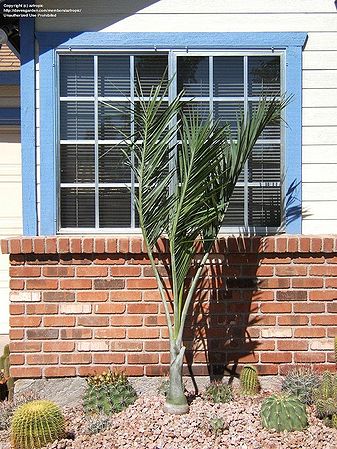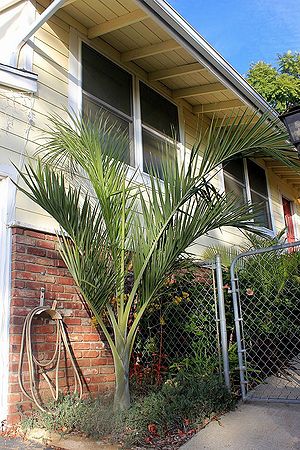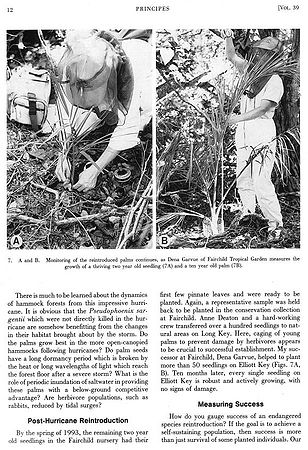Pseudophoenix sargentii
| Pseudophoenix (soo-doh-FEH-niks) sargentii (sahr-jent'-ee) | |||||||
|---|---|---|---|---|---|---|---|
 Cuba. Photo by Paul Craft. | |||||||
| Scientific Classification | |||||||
| |||||||
| Synonyms | |||||||
|
| |||||||
| Native Continent | |||||||
|
| |||||||
| Morphology | |||||||
| |||||||
| Culture | |||||||
|
| |||||||
| Survivability index | |||||||
|
| |||||||
| Common names | |||||||
|
| |||||||
Contents
Habitat and Distribution
Pseudophoenix sergeantii is found in the Bahamas, Belize, Cuba, Dominican Republic, Florida, Haiti, Mexico Southeast, Puerto Rico, Turks-Caicos Islands, and the Windward Islands. Pseudophoenix sargentii is found in coastal habitats, although one site in southern Quintana Roo, Mexico, is more than 30 km inland (where the palm population is thought to represent relic populations along an ancient coastline) (Quero 1981). It occurs on limestone or dune sand over limestone in seasonally dry forest, tropical hammock, coastal scrub, etc. (Seifriz 1943, Ledin et al. 1959, Read 1968, Quero 1981). Under harsh conditions, it grows very slowly such that mature individuals have trunks less than 50 cm tall. It grows easily but slowly in cultivation, a situation which has contributed to the destructive practice transplanting wild specimens to gardens and landscapes. (S. Zona. 2002)/Palmweb.Pseudophoenix occurs on well drained sand, or porous limestone, near the coast or inland on dry hills. A FLORIDA NATIVE: First discovered in USA in 1886 on Elliot Key, an island 10mi from Miami, FL... Soon thereafter found on Sands Key, and Long Key as well...
Description
Solitary; 10-25 feet tall; trunk 6-12 inches wide, canopy 8-12 feet wide, crown holds 8-12 fronds, Leaves are greenish-blue above and silvery below, with erect leaflets distributed in different planes. Pseudophoenix sargentii var. navasana, which originates from the Navassa Island (Coastal Haiti), can be differentiated by the leaflets, white above and silvery below, Leaf Size: 4-9 feet long; leaflets 2 feet long, 2 inches wide, fruit globular, red fruits up to 1.7 cm in diameter. editing by edric.
Stems: Solitary, erect to 8 m tall and 30 cm in diameter, bulging slightly at variable points; young stems are gray-green, turning gray with age; ring scars are prominent, raised, and brown. Leaves: Pinnate, reduplicate, with a twisting rachis, to 3 m long, with linear, blue-green leaflets irregularly arranged in groups of three to five, at divergent angles, held in a more or less plumose, V-shape. The somewhat open, short, stout crown shaft is formed from waxy, gray-green or blue-green leaf sheaths. The leaflets have brown scales below, acute tips and obvious secondary veins. There are no spines. Flowers and fruit: Inflorescences maybe erect or arching, to 1 m long, and branched to five orders. Bisexual flowers are produced at the base of the inflorescence, with staminate flowers toward the tips; both are yellow in color. Fruits are 1-2 cm, spherical to ovoid or three-lobed, and scarlet red when ripe, with remnant sepals at the base. (idtools.org/)
| Detailed Scientific Description |
|---|
|
Stem 1–8 m tall, cylindrical, 9.5–25.0 cm in diameter breast high, gray, with prominent leaf scars when young. Leaves 7–16 in the crown, spreading or ascending; leaf 0.9–2.2 m long; sheath 18–41 cm long, green with silvery gray scales near the apex; petiole 24–119 cm long; rachis 64–165 cm long, often with brown scales along its margin; leaf segments 37–122 per one side of the rachis; middle leaf segment 29–64 cm long, 0.9–3.2 cm wide, lanceolate with an acuminate tip, gray-green, glaucous abaxially, glaucous to glossy adaxially, ramenta present on the abaxial surface of the midvein at the base of the leaf segment. Inflorescence erect, ascending or horizontal, branched to 3 or 4 orders, 100–150 cm long; peduncle often hidden by the leaf bases, 60–88 cm long, 1.7–1.8 cm in diam., glabrous; prophyll 24–105 cm long, 2.6–6.0 cm wide, bearing dark brown scales along both edges (keels); inner bract 10–74 cm long, 1.6–5.0 cm wide, bearing dark brown scales along both edges; rachillae 1.3–5.5 (–9.0) cm long and 0.4–1.4 mm in diam., strongly divaricating. Flower pseudopedicel 2.2–7.6 mm long, 0.4–1.0(–1.7) mm in diam., green to glaucous; calyx a shallow triangular cupule, 2.1–4.2 mm in diam., green to glaucous, margins hyaline; petals ovate, 4.8–6.6 mm long, 3.2–4.8 mm wide, green, glaucous abaxially, spreading, with about 7–13 major veins; filaments 2.2–3.7 mm long, basally connate forming a short staminal tube, anthers ovoid, 2.4–4.1 mm long, 0.8–2.5 mm wide, yellow; gynoecium (in bisexual flowers) 3.0–4.2 mm long, 1.0–2.3 mm in diam. (pistillode in staminate flowers smaller), green. Fruit 10.6–17.1 mm long, 9.1–16.1 mm in diam. (in single-seeded fruits); endocarp 7.9–13.5 mm long, 6.8–11.8 mm in diam., 0.1–0.2 mm thick. Seed 6.4–10.5 mm long, 6.6–9.6 mm in diam. (S. Zona. 2002)/Palmweb. Editing by edric.
|
Culture
Growth Rate: Slow, Salt Tolerance: High, Light Requirements: Moderate to high, Drought Tolerance: High, once established, Soil: Widely adaptable, Nutritional Requirements: Low, Propagation: Seeds
Prefers lightly shaded, moist, but well drained position, preferably on alkaline soils. Very salt water tolerant. Extremely slow growing. The seeds are long lived for palms, germinating after as much as two years in storage. Fruits become buoyant when dry and may be dispersed by sea. U.S.D.A. Zone: 9b+. (28°F Minimum).
Comments and Curiosities
Etymology: The specific epithet honors; Charles S. Sargent, the first collector of the type.
"Popular with south Florida folks because they are native and unique."
| read more |
|---|
|
Conservation: On the northern coast of the Dominican Republic, near Sosua, P. sargentii has been extirpated by coastal development. (Zanoni 1986). Several populations of this species are endangered, one critically so. In Florida, small populations remain on Elliott Key (Lippencott 1992), where they are protected, but have been extirpated from Long and Sands Keys, where they once grew. In Mexico, populations are threatened by coastal develop-ment and agriculture (Quero 1981, Durán 1995). The most seriously threatened population is that from the island of Navassa. Zanoni and Buck (1999) reported that Pseudophoenix on Navassa is now reduced to a single adult palm. Introduced goats prevent reproduction by eating seeds and seedlings. Unless immediate action is taken, this unique population will be lost in the wild (offspring from Navassa palms survive in cultivation). (S. Zona. 2002)/Palmweb. When the fruit is mature it is bright red, turning an average looking palm into a striking one. Their native (Florida) habitat is an island off the coast South of Miami but there historic distribution was even more widespread. They were found in the Keys south of the mainland too. All these palms were lost due to wild collecting and development. Some homes still have grand old specimens in their yards in the Keys. Another interesting fact is that they are not closely related to any other palm (except the other species). They were thought to be related to Wax palms from South America but an inspection of their genes found hundreds of matched pairs of chromosomes, something rare in both the palnt and animal kingdoms! When young, the leaves are disticate (in one plane) and another unusual thing about the Cherry Palm is that they hold one two or three seeds in one fruit. And last but not least they are about as salt and wind toleant as any palm. They can be found with their roots In salt water in the Bahamas. These plants are very stunted and produce fruit at only a few feet tall. They may have only a foot of wood and be skinny as 2-3 inches! & nbsp." (Ken Johnson) "Native US species (southern tip of Florida) and into the Caribbean. Known for it's powdery, ornamentally ringed and swollen trunk and cherry-like fruit in the east coast, here in southern California it is known mostly for being one of the slowest growing palms there are. Not a problem growing on in Florida, where it is usually warm, night and day. CAn handle some frost, but hates prolonged cool. Those who have had luck with it here in So Cal have exceptionally mild weather, or are just amazing palm growers. I have had several die on me in the ground, but they do fairly well in pots. Palm grows stiff, but not spikey, fronds, and has a unique look to it... the powdery blue-green coloration is very attractive and it is a really show stopper here in California. In Hawaii, this palm grows slow (not compared to here) but spindly-doesn't get the fat trunk like it does in Florida- not sure why. (Geoff Stein) "Rather slow growing but worth it. I have 6 sargentii's,2 ekmanii's,1 lediniana,and 1 vinifera in the ground in Mesa,Arizona.The plants seem to thrive under our conditions if a little protection to the trunk can be provided from direct sun.(Leaves take the sun fine but trunks sunburn in direct sunlight) All the plants only grow 1 new frond per year.The largest is 6 ft tall overall with a 6 inch dia. base." (Scott - Aztropic) This rare palm is found in coastal areas of the Florida Keys, the Bahamas, Hispaniola, a small area of Cuba, and very eastern Mexico. It has a slightly swollen, waxy, ringed trunk; a waxy crownshaft; and arching, dark grey-green, very leathery, pinnate leaves. The Buccaneer palm grows very slowly, but, because of its extreme coastal habitat, it will grow in almost any well-drained soil and is one of the most salt and wind tolerant of all palms, i.e. ideally suited for coastal planting. It will do well in both warm temperate and tropical climates. Unfortunately, it is now endangered in most of its native habitat and also is rare in cultivation. Even small plants fetch high prices in the nursery trade, and it is hoped that this fabulous and unusual palm will be a little more commonly cultivated in the future with the high-quality seeds we now have available in good quantities and on a regular basis. (RPS.com) The ones in the photos with much wider spaced rings, and void, or nearly void of a swollen trunk, are more than likely all var. navassana, which are considerably faster growing as well. Natural Geographic Distribution: Buccaneer palm, Pseudophoenix sargentii, is an endangered Florida native, once found in abundance in the upper Florida Keys. Wild collecting and development have greatly reduced its numbers. It is also native to the Bahamas, Belize, Cuba, Dominica, Navassa and the Yucatan Peninsula. It grows well, albeit very slowly, in hot regions with erratic rainfall and limey soils. It is one of the most wind and salt tolerant palms, making it suitable for coastal plantings, where it can tolerate the occasional salt water inundation. Growth Habit, Morphology and Reproduction: Buccaneer palm produces a slender to moderately stout single trunk, a short crown-shaft, and pinnate fronds. The juvenile palm produces fronds in a single plane until the palm grows a trunk, at which time the palm forms a radius around the bud. The trunk is often irregularly formed but often wider at the base. It has closely spaced conspicuous ring scars and no dead leaf bases on mature specimens. The trunk matures from a light to dark gray on the older parts. The short, slightly bulging crown shaft is 1 to 2 feet tall, smooth, waxy, and bluish to silvery green on younger palms and dark yellow green on older specimens. Typically, this palm produces only 1 or 2 new fronds a year. In its juvenile stage, each new frond is significantly larger than the previous one. At maturity it has 8 to 12 fronds in the crown that are 4 to 9 feet long with petiole length of 8 to 20 inches. The fronds are dark yellow green above and silvery underneath. The bee-attracting inflorescence is erect and much-branched. It grows from among the leaves rather than beneath the shaft, as with most crown-shafted palms. The many small greenish-yellow flowers are mostly bisexual or with separate male and female flowers. Flowering occurs year round, followed by many green drupes which ripen to a bright red. Each thin flesh fruit holds 1 seed which will germinate naturally on the ground beneath the palm. Seeds are easily germinated. Remove the outer pulp and let them dry for 5 to 7 days. After which, soak them in water for two days. Soaked seeds are then planted no deeper than 1/2 inch. Most will germinate in six to eight weeks. |
- IMAGE GALLERY
External Links
- Glossary of Palm Terms
- MODERN BOTANICAL LATIN
- "Just To Be Clear"
- Photos Too
- http://lee.ifas.ufl.edu/Hort/GardenPubsAZ/Buccaneer_palm.pdf
- http://www.youtube.com/watch?feature=player_detailpage&v=uOICmFsV5PU
- Reintroduction of Pseudophoenix sargentii in the Florida Keys IPS intro
- Reintroduction of Pseudophoenix sargentii in the Florida Keys
- A Must See
- http://www.palmtalk.org/forum/index.php?/topic/22163-pseudophoenix-sargentii/
- idtools.org/
References
Phonetic spelling of Latin names by edric.
Special thanks to Geoff Stein, (Palmbob) for his hundreds of photos.
Special thanks to Palmweb.org, Dr. John Dransfield, Dr. Bill Baker & team, for their volumes of information and photos.
Glossary of Palm Terms; Based on the glossary in Dransfield, J., N.W. Uhl, C.B. Asmussen-Lange, W.J. Baker, M.M. Harley & C.E. Lewis. 2008. Genera Palmarum - Evolution and Classification of the Palms. Royal Botanic Gardens, Kew. All images copyright of the artists and photographers (see images for credits).
Zona, S. 2002. A Revision of Pseudophoenix. Palms 46 (1) 19-38.
Many Special Thanks to Ed Vaile for his long hours of tireless editing and numerous contributions.









































































































